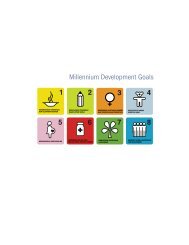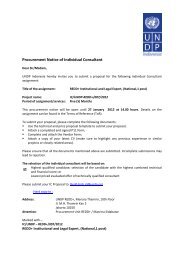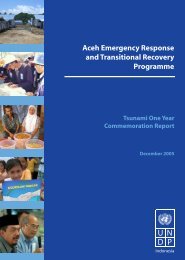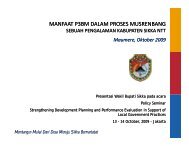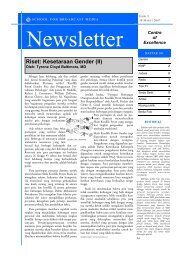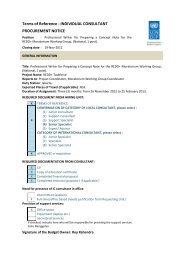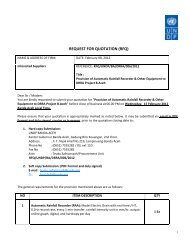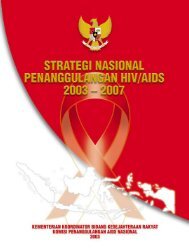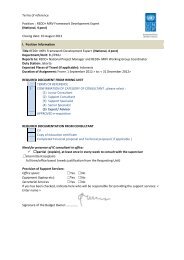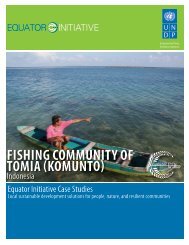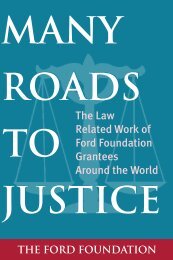Papua Needs Assessment - UNDP
Papua Needs Assessment - UNDP
Papua Needs Assessment - UNDP
Create successful ePaper yourself
Turn your PDF publications into a flip-book with our unique Google optimized e-Paper software.
After the promulgation of the OTSUS law, a Grand Strategy for <strong>Papua</strong> was developed locally. In<br />
effect, it is a provincial government document that expresses the priority areas for development in<br />
the region, which, as noted earlier, are health, education, community livelihoods and infrastructure.<br />
While the Grand Strategy is known within provincial government in Jayapura, the PNA team found<br />
that there was limited awareness or ownership of the Strategy amongst other stakeholders in<br />
<strong>Papua</strong>. At the same time however, consultations and workshops held throughout the PNA confirmed<br />
that there is broad agreement with the four priority areas that it highlights. The multi-stakeholder<br />
Synthesis Team that synthesised findings from the PNA and contributed greatly from their respective<br />
experiences and knowledge, worked with the Regional Planning Agency (BP3D) on formulating a<br />
draft <strong>Papua</strong> General Development Framework for <strong>Papua</strong> to achieve by the year 2025. This draft<br />
has been used as a local resource to support government in preparing medium and long term<br />
development plans for <strong>Papua</strong>. Similar to OTSUS, the vision expressed in the draft framework<br />
uphold the importance of <strong>Papua</strong>ns being “socially, culturally, economically and politically selfreliant,<br />
in line with traditional (adat) and universal values”. To achieve such a vision, the missions<br />
proposed in the draft framework were:<br />
• Recognition of <strong>Papua</strong>’s traditional, religious and cultural rights, as well as the<br />
indigenous peoples’ right to development;<br />
• Social welfare and justice, particularly in health and education;<br />
• Equitable and self-reliant economic development;<br />
• Sustainable environmental and natural resources management; and<br />
• Well-developed political and governance systems based on <strong>Papua</strong>’s cultural<br />
values, within the context of the Indonesian nation-state (Synthesis Team, 2005).<br />
4.2 Administrative division<br />
The central Government’s decision to divide <strong>Papua</strong> into three provinces (<strong>Papua</strong>, West Irian Jaya<br />
and Central Irian Jaya) has been perceived differently by different actors. Restructuring is seen<br />
by some as an initiative to bring the seats of government closer to the people in order to accelerate<br />
the pace of development. The formation of new provinces and kabupaten (see Table 2) was also<br />
done concurrently with the restructuring of some districts (kecamatan) and villages so that local<br />
government offices would be physically closer to communities 4 . For others, the division of <strong>Papua</strong><br />
into three provinces is seen as an effort by Government to create division in <strong>Papua</strong> and as a<br />
violation of Law No.21/2001, which requires the approval from the Majelis Rakyat <strong>Papua</strong> (MRP-<br />
<strong>Papua</strong> People’s Council) and DPRP (<strong>Papua</strong> Legislative Council) for any such division. The<br />
controversy arose because Law No.45/1999 that divides <strong>Papua</strong> in three provinces was issued<br />
prior to Law No.21/2001 that provides <strong>Papua</strong> with its Special Autonomy. That division of the<br />
province continues to be implemented is, for many <strong>Papua</strong>ns, an indication that the central<br />
government is removing the powers of the MRP before it has been established. For most <strong>Papua</strong>ns<br />
the MRP symbolizes the essence of the <strong>Papua</strong>n struggle to gain acknowledgement of their<br />
unique cultures and identities and is seen as the mechanism that will give voice and representation<br />
to local people.<br />
Law No.45/1999 not only split <strong>Papua</strong> into three provinces but also provided for the formation of<br />
three new kabupaten (Puncak Jaya, Paniai and Mimika) and 1 new City (Sorong). A much more<br />
drastic administrative restructuring took place with in 2002 with Law No. 26/2002, which added as<br />
many as 14 new Kabupaten, and in 2003 with Law No.35/2003 another Kabupaten (Supiori),<br />
bringing the total to 2 cities (Jayapura and Sorong) and 27 kabupatens. One clear effect of the<br />
creation of new administrative units is a reduction in the average size of kabupaten populations,<br />
which in all administrative units of government are now far lower than before the restructuring and<br />
4<br />
In <strong>Papua</strong> the administrative unit known elsewhere in Indonesia as ‘kecamatan’ (sub-district) is referred to as<br />
‘distrik’ and ‘desa’ (village) is referred to as ‘kampung’. In this report, the Indonesian term ‘kabupaten’ is retained,<br />
whereas the English ‘district’ and ‘village’ are used for ‘distrik’ and ‘kampung’. To avoid confusion, where ‘district’<br />
appears, it is followed by ‘kecamatan’ in parentheses.<br />
15



